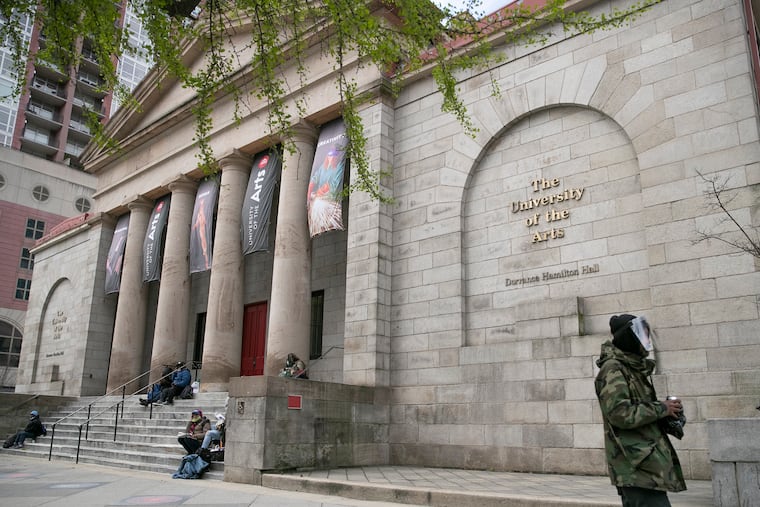University of the Arts raises $67 million in its first capital campaign. Here’s how it’ll be used.
Renovations of historic buildings, a boost for endowment, and money for scholarships are among the enhancements to the arts school.

The University of the Arts has completed its first-ever comprehensive capital campaign, raising money for campus renovations, scholarships, endowment, and more. The arts school on South Broad Street aimed for $50 million in gifts when it launched the effort in 2018, but has ended up exceeding the goal by a considerable amount.
The campaign pulled in a total just north of $67 million, the school announced Tuesday.
“It’s extraordinarily exciting because many people felt we could never hit $50 million,” said David Yager, University of the Arts president and CEO.
Where did the school — which didn’t have a particularly well-developed tradition of philanthropy — find support for the campaign? Yager lists sources in several categories:
“Trustees who had never given very large gifts have stepped up. People that I’ve built a relationship with or the institution has a relationship with. Some alumni who popped up, 50-years-ago alumni who never had kids, those kinds of things. A lot of non-alumni who are just supporting what we’re doing.
“A lot of them were surprises,” Yager said in an interview. “I was basically told there was nobody on the board who would give you a seven-figure gift, and we proved that wrong.”
The single-largest donation to the campaign was $25 million from the estate of Dorrance “Dodo” Hill Hamilton, the late Campbell Soup heiress who served on the school’s board for decades, a number of them as board chair.
The arts school entered the campaign hoping to build dorms, and at one point eyed becoming a partner in a larger development on the southwest corner of Broad and Lombard Streets. With rents going up in Center City, the question of student housing has become more urgent.
The plan now is for the university to try to sell Pine Residence Hall at 15th and Pine Streets and to use the proceeds to improve the school’s existing housing in several other buildings, said Yager.
Most of the school’s current residences “were never designed properly, they were just apartments, and then we did what I would call a modest conversion rather than really going in and making them like residence halls should be today,” he said. “And because we have good locations and because a lot of the rooms have way too much space because they’re apartments, we probably will get very close to the same number of students [as it has with Pine Hall] if we go in that direction.”
Plus, he said, not partnering with a developer allows the school to “control our future in terms of paying rent to someone else and worrying if we didn’t fill them and all those kinds of things.”
Money from the just-completed campaign, dubbed “Uniquely UArts: The Campaign for Creative Capital,” will be spent and saved for a variety of efforts.
The biggest chunk, about $24 million, will be kept in perpetuity in endowment.
About $17 million is being used for capital projects, like a new student center in the former Gershman Y building at Broad and Pine Streets, the Laurie Wagman Recording Studios, and “Living Steps,” a new gathering space for students.
Restricted funds totaling about $14 million are being used for programs and academic disciplines.
$5.5 million will go toward scholarships.
About $5 million is being set aside as discretionary funds — for expenditures like tuition relief, housing costs, food expenses, and art supplies.
The university, which typically has about 1,500 students, offers undergraduate and graduate degrees in its music, art, dance, theater, film, design, and other schools, and traces its roots to 1876.
One major element in the campaign was the renovation of the Philadelphia Art Alliance building. The school took over the alliance and acquired its Italian Renaissance-style structure in 2017, giving the university a presence in Rittenhouse Square for art exhibitions and other events.
Building systems were modernized, with historic elements — plaster, molding, and woodwork — restored. “Everybody who walks in says, ‘Wow, this feels like a new building but still has all the beauty of what the building was,’” Yager said.
In the works back on Broad Street, in the old Gershman Y, are a new student center and a film-screening room for both students as well as the public.
The university gave up a major arts hall in its space reshuffling of the past few years by selling the Merriam Theater (now called the Miller Theater) to the Kimmel Center for $11 million.
“We did lose a performance space, not a good one but we lost a performance space,” said Yager, “and that’s still been really problematic for large performances. And the cost of rentals has just gone off the deep end in terms of spaces, so we’re still trying to work on that.”
In addition to the immediate material benefits to the university, the completion of a first-ever comprehensive campaign helps to establish a tradition of philanthropy that had been lacking compared with some other schools.
The needs are ongoing. Still unfunded: a renovation of the Arts Bank at Broad and South Streets, and a new dance studio for the Gershman building. Those projects likely won’t be funded through another large capital campaign, but by holding conversations with individual donors, Yager said.
With all of the “terrible things that have gone on in the world in the past couple of years,” he said, “we still have some really amazing good stories about people stepping up and being generous. You read about the bad stuff, but there are many more good people out there doing really good stuff.”